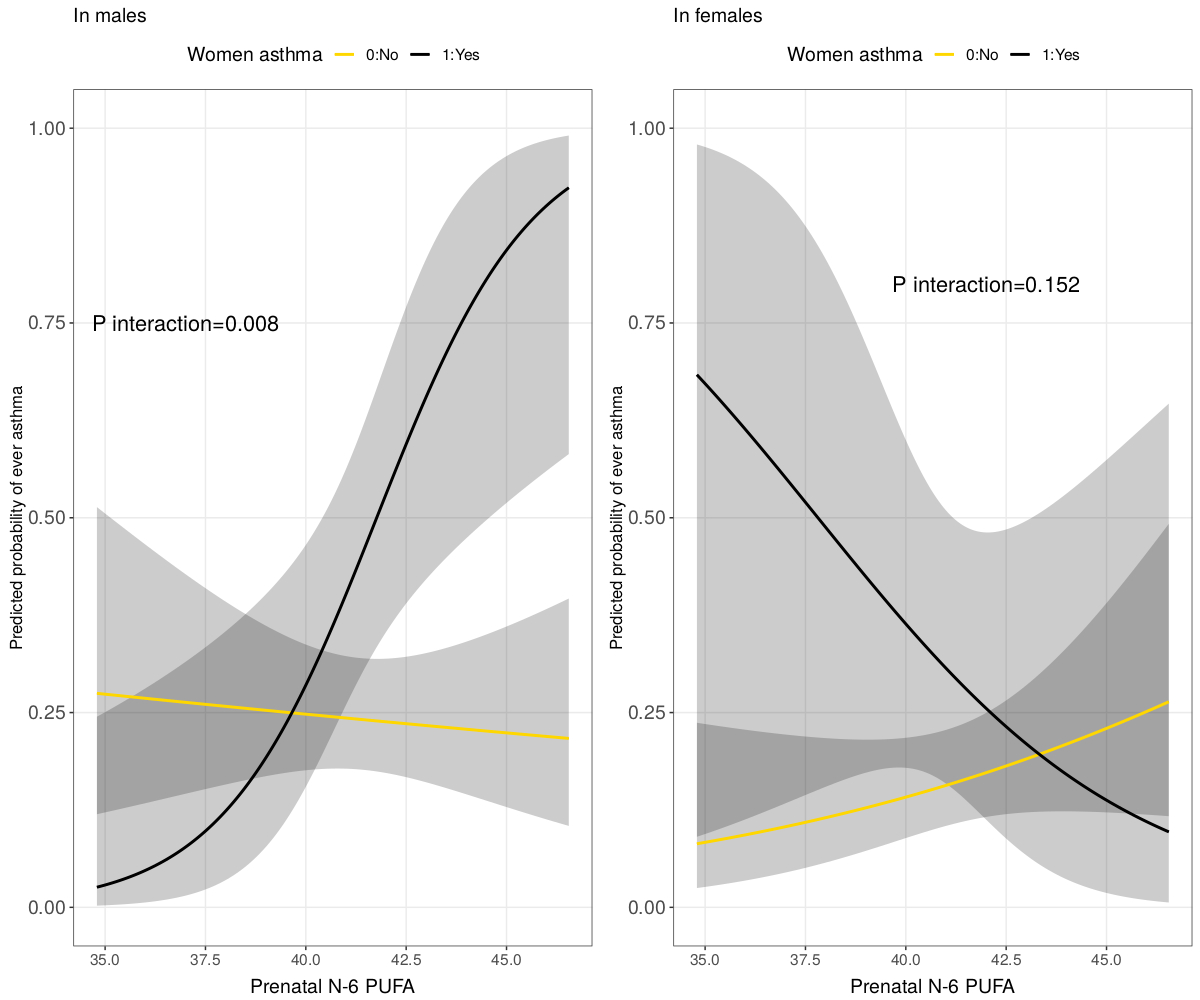Back
Asthma
Category: Abstract Submission
Asthma
42 - Prenatal Omega-6 Polyunsaturated Fatty Acids And Asthma in Middle Childhood: Effect Modification by Child Sex and Maternal Asthma
Sunday, April 24, 2022
3:30 PM – 6:00 PM US MT
Poster Number: 42
Publication Number: 42.300
Publication Number: 42.300
Julie D. Flom, Yale University School of Medicine, Weston, CT, United States; Marshae Nickelberry, Vanderbilt University School of Medicine, Nashville, TN, United States; Tebeb Gebretsadik, Vanderbilt University School of Medicine, Nashville, TN, United States; Margaret Adgent, Vanderbilt University Medical Center, Nashville, TN, United States; Terryl J. Hartman, Rollins School of Public Health, Emory University, Atlanta, GA, United States; Nicole Bush, University of California, San Francisco, School of Medicine, San Francisco, CA, United States; Kaja Z. LeWinn, University of California, San Francisco, School of Medicine, San Francisco, CA, United States; Alex Mason, University of Tennessee Health Science Center College of Medicine, Memphis, TN, United States; Qi Zhao, University of Tennessee Health Science Center College of Medicine, Memphis, TN, United States; Rosalind J. Wright, Icahn School of Medicine at Mount Sinai, New York, NY, United States; Kecia N. Carroll, The Icahn School of Medicine at Mount Sinai, New York, NY, United States

Julie D. Flom, MD MPH (she/her/hers)
Assistant Professor
Yale School of Medicine
Weston, Connecticut, United States
Presenting Author(s)
Background: Childhood asthma has in utero origins with potential influence from prenatal nutritional exposures such as Omega-6 (n-6) polyunsaturated fatty acids (PUFAs). Omega-6 PUFAs are inflammatory nutritional compounds and higher prenatal exposure may impact lung development and predisposition to asthma. Understudied attributes such as effect modification may contribute to inconsistencies seen in the association between prenatal n-6 PUFAs and childhood asthma.
Objective: To investigate the association between prenatal n-6 PUFA status and asthma in mid-childhood (age 8-9 years) and explore effect modification by maternal asthma and child sex.
Design/Methods: Participants included 912 mother-child dyads from Shelby County, Tennessee enrolled, 2006-2011, in the prospective prenatal CANDLE cohort. Prenatal n-6 PUFA status was characterized using second trimester plasma samples. We assessed parental report of child ever asthma and current asthma (at least 2 of the following: ever asthma diagnosis or asthma-specific symptoms or medication use in the past 12 months). We estimated the association between prenatal n-6 PUFAs and child asthma using multivariable logistic regression (controlling for maternal age, race, education level, parity) and investigated interaction of maternal asthma history and n-6 PUFAs stratified by child sex.
Results: Among women (65% Black; 34% White), 12% had asthma. Overall, 18% of children had ever been diagnosed with asthma and 12% had current asthma. We did not detect a statistically significant association between prenatal n-6 PUFAs and child asthma in overall models. In models assessing interaction between prenatal n-6 PUFAs and maternal asthma stratified by child sex, higher n-6 PUFAs were associated with increased relative odds of ever asthma in boys born to mothers with asthma (pinteraction < 0.05), an association not seen in girls (Figure).Conclusion(s): In a large, diverse prenatal cohort with follow-up through age 8-9 years, we detected a three-way interaction between prenatal n-6 PUFA status, maternal asthma history, child sex and child asthma diagnosis. Maternal asthma and child sex should be considered in design and interpretation of future studies. In the context of a growing body of literature, these results can help guide interventions for those at highest risk.
Figure Predicted probability (solid line) and 95% Confidence Interval (shaded area) of ever diagnosis of child asthma across prenatal n-6 PUFA level stratified by maternal asthma; boys (left) and girls (right)
Predicted probability (solid line) and 95% Confidence Interval (shaded area) of ever diagnosis of child asthma across prenatal n-6 PUFA level stratified by maternal asthma; boys (left) and girls (right)
Objective: To investigate the association between prenatal n-6 PUFA status and asthma in mid-childhood (age 8-9 years) and explore effect modification by maternal asthma and child sex.
Design/Methods: Participants included 912 mother-child dyads from Shelby County, Tennessee enrolled, 2006-2011, in the prospective prenatal CANDLE cohort. Prenatal n-6 PUFA status was characterized using second trimester plasma samples. We assessed parental report of child ever asthma and current asthma (at least 2 of the following: ever asthma diagnosis or asthma-specific symptoms or medication use in the past 12 months). We estimated the association between prenatal n-6 PUFAs and child asthma using multivariable logistic regression (controlling for maternal age, race, education level, parity) and investigated interaction of maternal asthma history and n-6 PUFAs stratified by child sex.
Results: Among women (65% Black; 34% White), 12% had asthma. Overall, 18% of children had ever been diagnosed with asthma and 12% had current asthma. We did not detect a statistically significant association between prenatal n-6 PUFAs and child asthma in overall models. In models assessing interaction between prenatal n-6 PUFAs and maternal asthma stratified by child sex, higher n-6 PUFAs were associated with increased relative odds of ever asthma in boys born to mothers with asthma (pinteraction < 0.05), an association not seen in girls (Figure).Conclusion(s): In a large, diverse prenatal cohort with follow-up through age 8-9 years, we detected a three-way interaction between prenatal n-6 PUFA status, maternal asthma history, child sex and child asthma diagnosis. Maternal asthma and child sex should be considered in design and interpretation of future studies. In the context of a growing body of literature, these results can help guide interventions for those at highest risk.
Figure
 Predicted probability (solid line) and 95% Confidence Interval (shaded area) of ever diagnosis of child asthma across prenatal n-6 PUFA level stratified by maternal asthma; boys (left) and girls (right)
Predicted probability (solid line) and 95% Confidence Interval (shaded area) of ever diagnosis of child asthma across prenatal n-6 PUFA level stratified by maternal asthma; boys (left) and girls (right)